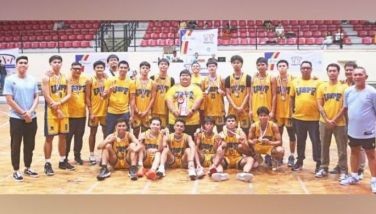Lessons from Taiwan
CEBU, Philippines - I was in Taiwan recently for an educational tour on clean coal technology initiated by the Cebu Energy Development Corporation (CEDC) in cooperation with its partner, Formosa Heavy Industries Inc. (FHI), one of the biggest conglomerates in Taiwan. The trip is part of CEDC’s aim to educate the public about this new technology, which it will adopt in its soon to be fully operational 3x82MW coal-fired power plant in Toledo City. The company feels a need to reach out and orient the people to counter negative perceptions about coal energy generation.
Coal is a vital fuel in most parts of the world. Records show that some 23% of primary energy needs are met by coal and 39% of electricity is generated from coal. About 70% of world steel production depends on coal feedstock. In other words, coal is the world’s most abundant and widely distributed fossil fuel source. The International Energy Agency expects a 43% increase in its use from 2000 to 2020.
However, burning coal produces about 9 billion tons of carbon dioxide each year which is released to the atmosphere, about 70% of this being from power generation. Other estimates put carbon dioxide emissions from power generation at one third of the world total of over 25 billion tons of CO2 emissions.
The development of clean coal technologies addresses this problem. Most countries in the world like the USA, Australia, Germany, Korea and Taiwan are putting substantial funding to clean coal technology R&D so that the world’s enormous resources of coal can be utilized for future generations without contributing to global warming.
In Taiwan, our “teacher” from FHI, Mr. Ken Tai took us to the company’s coal-fired power plants Jin Hsin and Hwa Ya. Surprisingly, both plants are located within populated communities. Jin Shin sits on a commercial area with a hospital, mall, and condominiums as next door neighbors. Hwa Ya is situated inside an industrial zone. This plant, which has a capacity of 300 megawatts, provides uninterruptible electricity to the more than 30 companies operating in the industrial zone and nearby commercial centers. Upon entering the two plants, visitors instantly notice the spank and cleanliness of the complex. You wouldn’t see dust and the plants’ smokestacks do not release black smoke.
Mr. Ken Tai said the clean coal technologies they adopted help them control or manage their wastes efficiently. The FHI power plants are run using the Circulating Fluidized Bed (CFB) Boiler System. Because of the clean coal technology that they adapted, waste products (fly ash) from FHI’s power plants are free from harmful chemicals. Mr. Tai proudly shared that they even earn extra income from selling their fly ash to cement companies which use this as a raw material for cement production. Moreover, fly ash can be used as additive to SMA (Stone Matrix Asphalt), a new road material to replace concrete asphalt. It has been found that CFB ash provides higher strength and longer life than limestone in SMA. Ash can also be used in land fertilization because it neutralizes acidic soil, replacing the role of limestone; provide additional magnesium to increase sweetness of fruits and vegetables; and protect plants from the attack of aluminum ions in soil.
On our second day in Taiwan, FHI hired seasoned tour guide Fannie to make our exploration of this beautiful country more educational. Fannie took us to Chiang Kai Shek Memorial Park to acquaint us with Taiwan’s most revered leader, Chiang Kai Shek who ruled the country with iron fist. He is well remembered for leading the wars in the east and north of China and against the Chinese Communist Party. Fannie said that throughout his life, Chiang strove for the modernization of the Republic of China. The great leader passed away in April 1975 and to perpetuate his memory, the citizens and overseas Chinese proposed to build a memorial hall. The proposal was accepted by the government and the memorial hall was built with donations from the public and appropriation from the government budget.
The Chiang Kai Shek Memorial Park boasts of over 25 hectares of landscape garden and ponds and pavilions, as well as the National Theater Hall and National Concert Hall. At the center of these is the Chiang Kai Shek Memorial Hall which rises 70 meters above the ground and is made attractive with white marble and blue glazed glass tiles. The memorial hall displays the collections of books and things that were once used by Chiang. The exhibition hall, with its 2000 square meters area, has six showrooms with relics of 11 categories. These relics left by Chiang include his clothes, hats, medals, document, photos, office things and more. One of the relics that got me in awe was Chiang Kai Shek’s sedan, a 1955 bullet-proof black Cadillac, because it was given to him by Filipino Chinese. The Chiang relics gave us a peek into the life of the beloved leader and the evolution and development of the modern history of China and Taiwan.
In the course of our tour of the memorial hall, I mentioned to Fannie how the park must have made a lot of money considering the magnitude that visit it daily. Fannie surprised me by saying that entrance to the park is free. So I asked, “Where do you get the money to maintain all of these?” She surprised me more when she said, “Oh, no worry. Our central government is very rich.”
In addition to the displaying of Chiang’s historical relics, the Memorial Hall serves as a platform for education, art and cultural promotion. It actively promotes life-long learning by offering a series of classes with abundant and multi-dimensional content. Classes such as Tai-ji Qigong, and yoga were given to promote the health and sustainability of the general public. Classes about appreciating ancient art works and seal carving were given to encourage people to appreciate the beauty of Chinese culture. There are also business-related programs to provide people with diverse learning opportunities so they can keep up with the global development.
All of these educational offerings at the Memorial Hall, according to Fannie, are in support of government’s efforts to meet the needs of a knowledge-based economy. In Taiwan, the people are its greatest asset. Government leaders work to deliver the basic services to the populace. For one, they enforced to the letter environment, waste management and anti-pollution laws to the point of charging high penalties for offenders. This makes all of Taipei very clean. You wouldn’t see thrash floating on rivers or dumped on roadsides. Instead you see lovely trees shading the streets. There is order on road because you have pedestrians and motorists obeying traffic rules. You smoke in a no smoking zone and you will be fined NT$10,000. From this observation, I came to a realization that strict implementation of the law makes for a disciplined citizen.
After our visit to the Chiang Kai Shek Memorial Park, Fannie took us to lunch at a revolving restaurant located on top of the smokestack of Taipei’s garbage incinerator. More than filling our tummy with the delectable dishes, the place afforded us yet another manifestation of how serious the Taiwanese work to preserve and maintain a clean environment. There was no foul smell there and the smokestack did not emit smoke. Power generated from the incinerator supplies electricity to the building and heats the public swimming pool nearby.
So many good developments are taking shape in Taiwan. I read from an English newspaper there about the Taiwan’s Environmental Protection Administration’s move to promote the use of eco-friendly vehicles to reduce pollution... Taipei mayor pushing for revitalized housing program for the poor ... more air access opened between mainland China and Taiwan..... electronic company offering 2,000 jobs to new graduates... But there is one thing that worries Fannie. “Tea drinking is a dying culture. The western culture of coffee drinking has taken over our youth. Before, you will see tea houses in every corner of the city. Now we have Starbucks and other coffee shops mushrooming everywhere!”
- Latest
- Trending


















